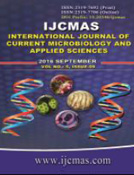


 National Academy of Agricultural Sciences (NAAS)
National Academy of Agricultural Sciences (NAAS)

|
PRINT ISSN : 2319-7692
Online ISSN : 2319-7706 Issues : 12 per year Publisher : Excellent Publishers Email : editorijcmas@gmail.com / submit@ijcmas.com Editor-in-chief: Dr.M.Prakash Index Copernicus ICV 2018: 95.39 NAAS RATING 2020: 5.38 |
This study was carried out to determine, using microbial and chemical standards methods, the chemical composition, the quality and the major microorganisms of Kawal, fermented Senna obtusifolia leaves consumed as a substitute of meat or an appetizing agent in Chad. The pH was ranged between 5.82 ± 0.19 and 7.22 ± 0.31,the acidity between 0.31 ± 0.00 and 0.54 ± 0.00 %, the dry matter content, 90.00 ± 0.00 and 92.46 ± 0.43%, the protein content, 15.52 ± 0.09 and 22.06 ± 0.07%,the ash content, 17.12 ± 0.01 and 19.3 ± 0.00%.The Total viable counts were between 9.7 × 109 and 2.7 × 1011 CFU / g; Bacillus sp., 3.7 × 108 and 9.1 × 109 CFU/g, lactic acid bacteria, 1.1 × 102 and 2.8 × 106 CFU/g; Staphylococcus sp., 1.5 × 103 and 3.7 × 107 CFU/g, Micrococcus sp.<10 CFU/g and 7.4 × 104 CFU / g. Yeasts and molds as well as enterobacteria were less represented or absent in most samples analyzed. Bacillus strains, the dominant microflora were isolated and grouped into 15 groups. Their biochemical and molecular characterizationshowed a high diversity involved in the fermentationof kawal among them B. subtilis, B. licheniformis, B. pumilus, and B. amyloliquefaciens were identified.
 |
 |
 |
 |
 |